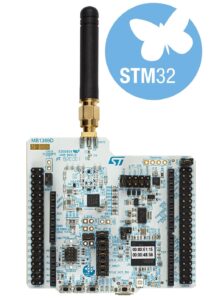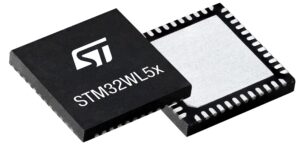The STM32WL5M is ST’s first LoRaWAN-certified module and the latest chapter in our sub-GHz democratization story. Indeed, ST started with STM32WLE, the first wireless MCU with an embedded multi-modulation radio. Then, engineers got two cores in the STM32WL5, one of them for the wireless stack, thus optimizing the creation of sub-GHz applications. Then, we released schematics, reference designs, and integrated power devices that are already fine-tuned for the STM32WL to further simplify design operations. Today, ST is adding a new twist with a module that integrates all these components into one package. We’ve already shown the STM32WL5M at conferences in 2023, and feedback has been very positive. Let’s understand why.
Why a module?
Practical conception
The STM32WL5M is our first LoRaWAN-certified module and the first to support two output powers thanks to its two power amplifiers. Hence, coupled with the wide frequency range supported by its STM32WL5x, the module can work in Europe, Americas, and Asia. Yet, despite all this, the device is still one of the smallest at 10 mm x 10 mm. Consequently, the module makes designing a sub-GHz application far more practical as it enables engineers to enjoy a comprehensive solution in a small package without having to deal with the complexity of creating it.
Practical implementation
Behind the scenes, we know many customers eye such modules for lower volume products, although numerous exceptions exist. ST thus aimed to make the STM32WL5M even more practical for products with smaller manufacturing objectives. For instance, we’ve ensured that it fits a two-layer PCB, requires no external passive components to enable features, and already includes an internal SMPS. Put simply, it simplifies the bill of materials as well as the PCB layout and helps significantly reduce the time to market, which is essential when building a lower-volume unit. Some versions (with part numbers ending in S) even include an STSAFE secure element to make it more practical for companies with critical security requirements.
Practical certification
As is traditional in a sub-GHz module, engineers only have to focus on the external antenna and the software stack. Because of the wireless requirements associated with such frequency bands, it is not feasible to include the antenna inside the package, like in the STM32WB modules. However, ST still aims to make the STM32WL5M more practical than competing solutions. As a result, we offer a reference design and documentation to help engineers easily kickoff their hardware PCB design. Additionally, the antenna-matching filters are already in the module. Furthermore, the STM32CubeWL firmware package includes a certified stack and example code, making the final certification process more straightforward.
Why LoRaWAN®?
In a survey presented at the 2017 International Symposium on Signals, Circuits, and Systems1, researchers established that LoRa® could solve the significant challenges that plague the widespread adoption of IoT devices. Its use of sub-gigahertz frequencies and its Chirp Spread Spectrum modulation technique enables the transmission of small packages over long distances while making it more resilient against interferences and more robust overall. Since then, LoRaWAN was formally enthroned by the International Telecommunication Union as a communication standard for “IoT and smart cities and communities”. According to the LoRa Alliance, there were more than 225 million LoRa/LoRaWAN end nodes in March 2022.
In another paper published in the International Journal of Electrical Power & Energy Systems2, scholars at Taiwanese universities showed that LoRa’s modulation stands up to interferences from electrical grids and provides a methodology to optimize the implementation of smart meters. They also make the point that smart grids are a great tool to reduce greenhouse gas emissions and meet standards set by the European Union. By embedding a radio, the STM32WL5 becomes an essential step toward democratizing the Long Range (LoRa) technology and adopting more sustainable energy consumption.
Prototyping Starts Here

The first challenge for most teams is rapidly developing a proof-of-concept. Demonstrating how to use the two cores of the STM32WL5 will be crucial when convincing managers. Consequently, ST launched its NUCLEO-WL55JC3, the first development board with an STM32WL55JC. It already comes with an external antenna and can, therefore, run applications out of the box. Developers simply need to load them using ST-LINK through the USB port.
On the software side, the latest version of STM32CubeWL includes application examples for this new Nucleo board to hasten developments. For instance, we provide a reference template to help build software that utilizes the two cores. Additionally, STM32CubeMX received an update enabling the configuration of the LoRaWAN and Sigfox stacks straight from the utility. We also offer demonstration programs that can send sensor data to a gateway or “Concentrator”. Since seeing is believing, a demo application running on this Nucleo board is the fastest way to show why the dual-core version of the STM32WL5 brings greater flexibility and security to projects.
STM32WL5x: Why a dual-core architecture?
2 cores to avoid re-certification with every update
The STM32WLE that we launched in January 2020 had a single Cortex-M4 that ran everything. Engineers that don’t need to update their applications frequently tend to prefer such architecture for its simplicity. However, some teams with more demanding constraints could have felt trapped, especially if a product requires frequent upgrades. If the network and applications stacks are on the same core, modifying any of it forces teams to re-certify the communication protocol. Thanks to the dual-core architecture of the STM32WL5x, developers sidestep this problem by putting the network stack on the Cortex-M0+ and the application on the Cortex-M4.
2 cores to avoid multiple qualifications

Another challenge comes from the need to qualify components. A small startup working on an IoT project tends to prioritize the most straightforward approach. In this regard, the STM32WLE and its single-core architecture is a great answer. For instance, we saw an automated rubber collection system that used the MCU to send alerts to the cloud. This smart agriculture system used the STM32WLE and relied on LoRa to help farmers optimize their operations. The system is a popular and high-volume product because the integrated nature of the microcontroller made it easy to develop a proof-of-concept.
However, when a large corporation works on a myriad of projects and supports multiple protocols, using one device for all of them is a tremendous asset. Indeed, the need to qualify only one component means a greater return on investment and a faster time to market. With the STM32WL5x, teams can create an application for the Cortex-M4 and numerous sub-gigahertz protocols on the Cortex-M0+ to suit their needs. Furthermore, it enables them to test various protocols more easily.
STM32WL5: why dual output power and multiple modulations?
2 power output to cover the world
All STM32WL5/E embed a specially engineered radio based on the Semtech SX126x that offers two power outputs: one up to 15 dBm and the other up to 22 dBm. Additionally, since the transceiver offers a linear frequency range from 150 MHz to 960 MHz, it is possible to use the STM32WL in every region worldwide. For instance, European standards demand that LoRa systems use the lower output and a frequency of 868 MHz, while North America can go up to 22 dBm and requires 915 MHz. Thus, developers can tailor the STM32WL series to their region, optimize its performance, and easily open their system to other countries.
The sub-gigahertz transceiver of the STM32WL5/E is compatible with LoRa, (G)FSK, (G)MSK, and BPSK modulation schemes. It’s easy to underestimate the scope of this feature. In a nutshell, it means the STM32WL5/E can run both a LoRaWAN stack through LoRa modulation and a Sigfox stack thanks to its support of Binary Phase Shift Keying (BPSK). Companies no longer have to choose between one or the other. Additionally, compatibility with (G)FSK, (G)MSK, and BPSK signifies that the STM32WL will also work with proprietary protocols that are popular among organizations looking to create unique solutions.
STM32WL5x: Why a Cortex-M0+ for more security?
2 reasons behind our dual-core architecture
ST decided to use the Cortex-M0+ for a myriad of reasons, but two particularly stand out. First, the dual-core approach offered similar performance and a more cost-effective structure for sub-gigahertz applications than larger cores. Second, it provides hardware isolation between each core and a key management service. It also enables authenticity verification, strong data decryption, and data integrity monitoring. The dual-core STM32WL5x also comes with many of our STM32Trust features, such as secure firmware install and update. Additionally, it has two unique IDs (64-bit and 96-bit) and offers multiple protection levels against read and write operations.
2 different approaches to the Cortex-M0+
The response from ST’s customers has been both positive and creative, with some using the STM32WL5 in an unexpected fashion. Indeed, most systems use the Cortex-M0+ for their sub-gigahertz protocol and the Cortex-M4 for their application. However, thanks to the flexibility of our implementation, some ST partners did the exact opposite. Some companies enjoyed the security benefits of the Cortex-M0+ for their sensitive application layers and put the radio stack on the Cortex-M4. Engineers always try to adapt to new security demands while making their products more accessible. The dual-core architecture of the STM32WL5 offers them a new tool to reach their objective.
STM32WL5x: Why do architectural optimizations matter?
2 power supplies and 1 crystal
ST engineers optimized power management by including a switched-mode power supply (SMPS) and a low dropout regulator (LDO) to shorten the STM32WLs’ wake-up from any low-power mode. It usually takes about 60 µs to get the SMPS ready, but thanks to the presence of the LDO, the MCU can wake in 5 µs or less even if the SMPS isn’t ready yet. When taking the STM32WLs out of sleep, stop, or standby, the system first uses the LDO and can thus start processing information while waiting for the SMPS to get ready.
The STM32WL5x also benefits from optimizations introduced on the STM32WB, the STM32 MCU that integrates a Bluetooth module. Traditionally, engineers need two 32 MHz external crystals: one that synchronizes with the Cortex-M4 and another for the LoRa transceiver. Thanks to our architectural implementations, the system only needs one crystal for the high-speed clock of the MCU and the radio, thus contributing to the reduction of the bill of materials and the PCB design simplification.
- A. Lavric and V. Popa, “Internet of Things and LoRa™ Low-Power Wide-Area Networks: A survey,” 2017 International Symposium on Signals, Circuits and Systems (ISSCS), Iasi, 2017, pp. 1-5. doi: 10.1109/ISSCS.2017.8034915 ↩︎
- Lain-Chyr Hwang, Chao-Shun Chen, Te-Tien Ku, Wei-Cheng Shyu, “A bridge between the smart grid and the Internet of Things: Theoretical and practical roles of LoRa”, International Journal of Electrical Power & Energy Systems Volume 113, 2019, Pages 971-981, ISSN 0142-0615, doi: 10.1016/j.ijepes.2019.06.001. ↩︎
- ST actually has two versions of the NUCLEO-WL55JC. The NUCLEO-WL55JC1 for Europe, USA, and countries uses higher radio frequencies while the NUCLEO-WL55JC2 for China uses 433/470 MHz frequencies. ↩︎
